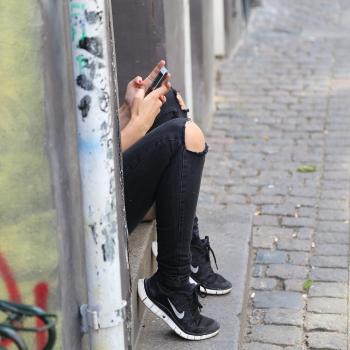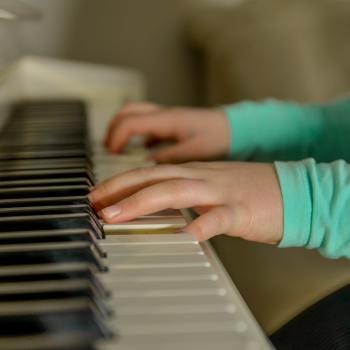Last week a woman named Terrie Elzie was shopping when her preschool-aged child had a meltdown in the checkout aisle. When the volume got especially loud, another shopper, Natalie Bree Hajek-Richardson asked Elzie to quiet her child. Elzie responded defensively, then Hajek-Richardson told her to go to hell. Next, Elzie followed Hajek-Richardson into the parking lot, saying “Where’d you tell me to go?”, and then punched Hajek-Richardson in the face. This was caught on surveillance camera. Hajek-Richardson lost several teeth, and Elzie has been arrested for battery. You can read more here, here, and here.
I have seen multiple mothers defending Elize’s actions. According to them, Hajek-Richardson deserved what she got, and should have known better than to suggest that Elzie quiet her child. I’m rather horrified by this response. To me, Elzie’s actions don’t speak of the depth of her annoyance, they speak of anger management problems. Getting annoyed is normal and okay—for both parties, in this case. Responding to that annoyance by punching someone in the face is not normal or okay. If the parties were reversed, it could have been the annoyed shopper who punched out the mother of the child having a meltdown. That wouldn’t be any more okay than this is.
This isn’t the first time I’ve noticed disagreement over this issue of children in public spaces. Only last weekend, the comment thread on my post about Bobby’s matchbox cars got out of hand when one reader questioned why I’d allowed Bobby to take the cars into a store, other readers explained that a small toy often helps keep children happy during a shopping trip, and then somehow things dissolved into the internet equivalent of parents and adults without children shouting at each other.
I honestly don’t understand why this has to be so complicated. When it comes to children in public spaces, people need to be understanding and parents need to be considerate.
Being out with a young child in public is frequently exhausting, and I say this as someone whose children are generally fairly well behaved. Just the other night I begged a few cups of flour off of a neighbor when I realized we were out in the middle of making cookies, because packing two small children into the car and heading to the store for flour sounded so like so much work. Being a young child is hard too, especially given that behavioral expectations often don’t take normal childhood development into account. Sometimes children have meltdowns, that’s how it works. You would too, if you were in their shoes!
It would be easy to suggest that if taking young children out can be so hard on both parent and child, they should just stay home. It’s not so simple. My mother tells stories of days on end without leaving the house when my siblings and I were small, and of going stir crazy and calling my father at work just so that she could “hear the sound of an adult voice.” It’s unfair to expect parents of young children to simply not go out. Children and parents have just as much right to public spaces as anyone else.
Parents can try to prevent a meltdown by making sure not to take a child shopping when she is tired or hungry, but even the best laid plans can go awry. Once a meltdown has begun, there is generally very little a parent can do but wait it out. If you, as another adult, ask a mother whose child is having a meltdown to “do something about it,” exactly what is it you expect that parent to do? If a child is having a meltdown, that parent isn’t any happier about it than you are. When a meltdown is in progress, the child is beyond listening to persuasion—and besides, parents who try to end a meltdown by offering at treat are often judged by other adults for doing so. For the parent, there is simply no way to win. Harsher tactics like threats of physical punishment are also unlikely to work—and is that really what you want, for the parent to respond to a child’s meltdown by hitting the child?
A meltdown, once in progress, must be waited out—that’s how meltdowns work. (If you don’t believe me, take a look at the literature on the subject, because I’m not pulling this out of thin air here.)
What about expecting a parent of a child who is having a meltdown in public to remove that child? When a child has a meltdown in public, the parent runs through a list of options. Leave? Stay? What does the child’s meltdown mean for the rest of the planned trip? Sometimes leaving is the best option, and I’ve done so myself on occasion. But sometimes the best option is to finish the current errand quickly and then scrap the second errand in favor of heading straight home.
In many ways, shopping ups the ante. Leaving the library or a similar public space mid-visit doesn’t mean going without needed groceries, but leaving mid-store often would. Elzie’s child had a meltdown in the checkout line, so I’m not surprised she chose to stay and finish rather than leaving a full cart. Please bear in mind that there are many parents for whom it is simply impractical to shop without their children. A stay-at-home parent often has children 24/7, and a working parent only has childcare during working hours. Shopping can be especially tricky for those who don’t have a parenting partner to help out and those who are lower income and must squish shopping in somewhere between long shifts at multiple jobs. Packing up a child mid meltdown and leaving is not always a feasible option.
All of this is to say that people need to be understanding.
If you are inconvenienced by a child having a meltdown, trust me, that child and her parent are having an even worse time. Making a comment about the noise is only going to make things worse. That parent knows that her child is making noise. If she could stop it, she would have already. So what should you do? Well for one thing, try not to glare or give judgmental glances. If anything, give the parent a sympathetic word or glance. I can’t tell you how much it means to have an adult smile and say “I’ve been there too, don’t worry, it does get better,” or some variant of it. Of course, it’s perfectly legitimate to feel annoyed and simply avoid eye contact, hurrying by and on your way. No one is asking you to like being around a child having a meltdown. Trust me, we don’t either!
But there’s another side to this, too, and that is that parents and young children need to be considerate.
It’s not pleasant to listen to a child having a meltdown. It’s not pleasant to have a meal interrupted by children running, bumping, or making excess noise. It’s not pleasant to be run into by a child with a mini shopping cart. Children should be welcome in public spaces with a certain level of understanding for their developmental needs, but at the same time a certain level of consideration for others should also be expected.
I’ve talked before about teaching children empathy. This is one place where I do that. It’s not about shaming children for acting in normal ways. It’s about saying “Sally, that woman is trying to eat her supper too, and talk to her friends. I know running back and forth across the restaurant is fun, but it’s disturbing other people. See? Come over here and let’s look at this book I brought while we finish eating.” Children should be taught how to behave in public spaces, and parents should set certain boundaries and help teach good behavior.
There are some parents who seem to feel that giving children boundaries in public spaces constrains them, and is somehow unfair. I understand the sentiment, but I disagree, because part of raising children has to do with teaching them appropriate behavior. It is our job to prepare them for the adult world, and that world does have certain rules and expectations. We should be understanding of children’s developmental needs, yes, and we should make allowances for that. But a behavior being “normal” does not make it acceptable. We teach our children not to hit other children; we also need to teach our children not to unnecessarily inconvenience other adults in public places. Other adults in those spaces need to understand that our children are still learning these things, but we need to hold up our part and make sure we are actually teaching these things.
We are also responsible for our children’s actions. Waiting out a meltdown is one thing, but allowing a child to hit others or throw things or dump out all the candy in the checkout aisle during that meltdown would be something else entirely.
There’s a balance to be struck here. Young children are developmentally different from adults, and allowances must be made. However, parents should make sure their children do not inconvenience others more than necessary and should work to teach their children to have consideration for others. There have been times when this goes too far in one direction, the extreme being the idea that children are to be “seen and not heard,” but it can go too far in the other direction too, when parents let their children “run wild” without consideration for how this may affect others.
What does all of this have to do with the news story I began this post with? Elzie’s child was having a meltdown in a public place. Since she was already at the checkout she probably decided to get through the line as quickly as possible and then get her child out of there. I would have done the same. I see nothing wrong with the calculus she made. Rather than being understanding (which I should point out doesn’t have to mean being happy about it), Hajek-Richardson asked Elzie to quiet her child, and then cursed her out when she failed to do so. Elzie had good reason to be upset. She did not, however, have good reason to follow Hajek-Richardson to the car and punch her in the face.
This story presents a good opportunity to talk about disagreements over the place of children in public spaces, and to promote understanding and consideration on both stories. Defending Elzie’s actions does the opposite.














